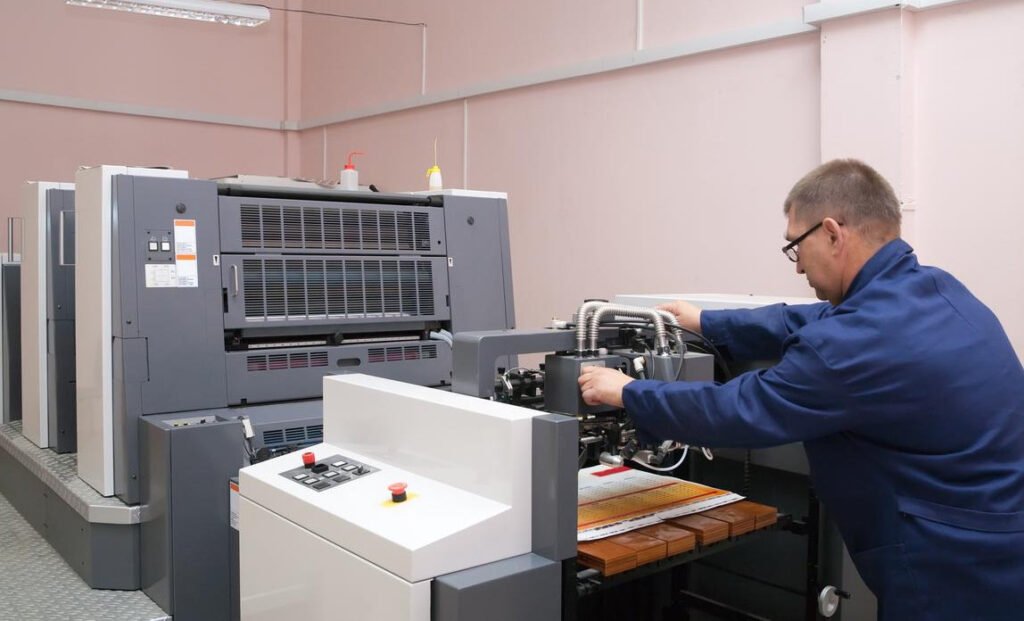
Table of Contents
The printing industry may be one of the oldest, but it’s far from obsolete. From business cards and brochures to large-format banners and custom packaging, demand for printed products continues to thrive in both the digital and physical realms. If you’re an aspiring entrepreneur wondering how to start a printing business, you’re in the right place.
This comprehensive guide will walk you through everything you need to know to launch and grow a profitable printing business—from strategic planning to client acquisition. Whether you’re aiming for a home-based startup or a commercial print shop, this roadmap is tailored to help you succeed in a competitive market.
1. Market Research and Business Planning
Before printing your first page, it’s critical to understand your market. Conducting thorough market research and creating a printing business plan will lay the foundation for long-term success.
Why Market Research Matters:
- Identifies demand for different printing services (e.g., business cards, apparel printing, packaging).
- Helps you analyze your competition—what they offer, their pricing, and customer base.
- Reveals underserved niches or local industries in need of print solutions.
Key Elements of a Printing Business Plan:
- Business objectives: Define your short-term and long-term goals.
- Target market: Determine whether you’ll serve small businesses, corporate clients, schools, or individuals.
- SWOT analysis: Identify your strengths, weaknesses, opportunities, and threats.
- Pricing strategy: Compare competitors and calculate production costs to set profitable rates.
- Service offerings: Decide what you will print—paper products, promotional materials, labels, signage, etc.
Stat Check: The global commercial printing market was valued at over $433 billion in 2023, with projected growth fueled by packaging, advertising, and textile printing demands. (Source: Grand View Research)
2. Required Equipment and Technology
The equipment you’ll need depends on your specialization, but investing in quality hardware is non-negotiable for a successful printing business startup.
Essential Equipment:
- Digital Printers: Best for quick turnarounds and small runs (e.g., Xerox, HP Indigo).
- Offset Printers: Ideal for bulk orders; higher upfront costs but better per-unit efficiency.
- Large Format Printers: Required for banners, posters, vehicle wraps, etc.
- Finishing Equipment: Cutting machines, binding tools, lamination machines, etc.
- Computer Systems & Software: Design software like Adobe Creative Suite, print management tools, and RIP software.
Optional but Useful:
- Heat press machines (for t-shirts and mugs)
- Embossing or foil stamping tools
- UV printers for specialty materials
Tip: Start lean with digital printing if you have a limited budget. You can scale up to offset printing once you grow.
3. Initial Investment and Funding
Like any business, starting a printing company requires capital. Depending on the scale, your initial investment can range from $10,000 to $100,000+.
Budgeting Breakdown:
- Equipment & software: $5,000 – $50,000
- Lease or setup (if not home-based): $1,000 – $5,000/month
- Inventory (paper, ink, packaging): $2,000 – $10,000
- Marketing: $500 – $5,000
- Licensing & legal: $300 – $1,000
Funding Options:
- Personal savings or bootstrapping
- Small business loans
- Equipment financing
- Crowdfunding or grants
- Investors (for scalable or niche models)
Pro Tip: Explore local or government-funded entrepreneurship programs for grants, particularly if you’re offering sustainable or community-focused services.
4. Legal Requirements and Business Registration
Operating legally is a must. Follow these steps to ensure your printing business is compliant:
Steps to Legal Setup:
- Choose a business structure: Sole proprietorship, LLC, or corporation.
- Register your business name: Verify availability and register with local authorities.
- Obtain an EIN: Necessary for taxes and opening a business bank account.
- Apply for business licenses: May vary depending on your state or country.
- Set up accounting: Use software like QuickBooks to manage income and expenses.
- Insure your business: Get liability and equipment insurance to protect your assets.
Challenge: Compliance laws differ by location. Always consult a legal professional or small business advisor.
5. Marketing and Client Acquisition Strategies
Once your printing business is set up, it’s time to bring in customers. Marketing is where your brand gains visibility and trust.
Branding Essentials:
- Create a logo and brand identity
- Build a professional website with service pages, a portfolio, and contact forms
- List your business on Google My Business and industry directories
Client Acquisition Tactics:
- Local SEO: Optimize your site for keywords like “printing service near me” or “custom business cards in [city].”
- Social Media Marketing: Use platforms like Instagram, LinkedIn, and Facebook to showcase work and engage with businesses.
- Email Marketing: Target small businesses, schools, and event organizers with custom offers.
- Networking: Attend trade shows, local business meetups, or chamber of commerce events.
- Referral Programs: Offer discounts to customers who refer new clients.
SEO Tip: Incorporate keywords such as “printing business startup” and “printing business strategies” in your content to attract organic traffic.
6. Potential Printing Niches and Specializations
Choosing a niche can set your business apart and allow you to charge premium prices.
In-Demand Printing Niches:
- Promotional Products: Custom mugs, pens, and T-shirts for businesses.
- Eco-Friendly Printing: Sustainable materials and inks for environmentally-conscious clients.
- Packaging & Labels: For small businesses, cosmetics, food products, etc.
- Wedding & Event Printing: Invitations, banners, signage.
- Print-on-Demand: Sell customized designs online without keeping inventory.
Success Strategy: Focus on a niche with recurring demand, like packaging or branded merchandise for businesses.
Final Thoughts: Turning Ink into Income
Starting a printing business is more than just running machines—it’s about delivering value through high-quality products, on-time service, and innovative solutions. By following the steps outlined in this guide, you’ll be better prepared to not only enter the industry but thrive within it.
Remember, building a profitable business takes time, persistence, and a willingness to adapt. With the right planning, tools, and mindset, your printing venture can make a lasting mark—literally and financially.
Ready to launch your printing business?
Start by drafting your business plan, researching your market, and selecting the right equipment for your goals. Your entrepreneurial journey in the printing world begins now.
